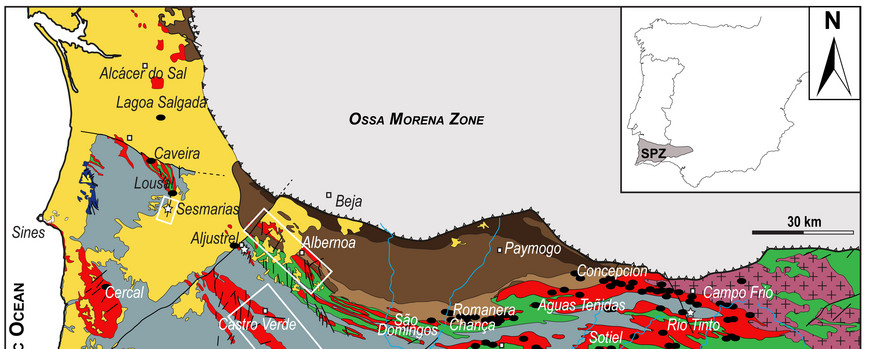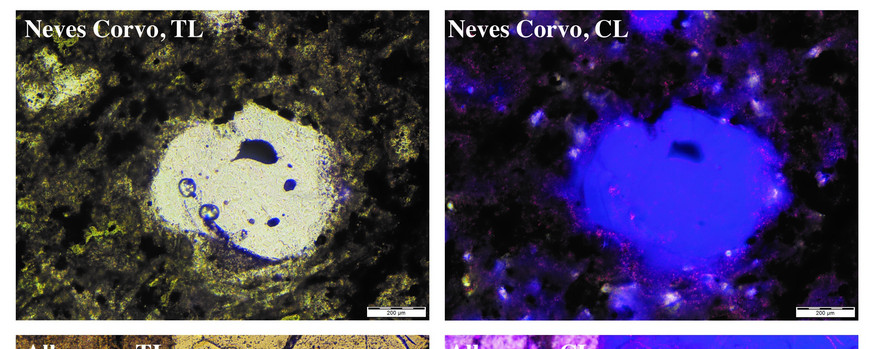Melts-Fluids-Models: keys to understanding ore-forming processes at the world-class Neves Corvo massive sulphide deposit, Iberian Pyrite Belt
The Iberian Pyrite Belt (IPB) in Portugal and Spain is a world-class metallogenic province that contains more than 1600 Mt of massive sulfide ore in over 100 deposits (Fig. 1) (e.g., Tornos, 2006). The orebodies are hosted by submarine lithologies comprising felsic volcanic rocks and black shales and, therefore, share characteristics with the sedimentary-hosted (SEDEX) and the volcanogenic massive sulfide (VMS) deposits. Hydrothermal activity at mid-ocean ridges and submarine arc volcanoes has been inferred to be a modern analog for forming these giant submarine deposits, but none of the known modern hydrothermal fields contain the tonnage, density of occurrence, or size of the IPB district. The classic conceptual models assume that metal-bearing, high-salinity hydrothermal fluids (brines) vent into anoxic-euxinic domains of the paleo-ocean where they precipitate massive sulfide ores during sedimentation of black shales (e.g., Tornos and Heinrich, 2008). However, most deposits lack unequivocal evidence for exhalation into anoxic seawater, and sulfide reduction may instead be related to early diagenetic processes of shales in oxygenated oceanic environments with high organic, where basin restriction may impose mass balance limitations of sulfur availability, hence inhibiting the formation of large, massive sulfide deposits (e.g., Reynolds et al., 2015; Magnall et al., 2016). Nevertheless, the future supply of raw materials will come from giant ore deposits, so the formation mechanisms of world-class systems remain a key issue in economic geology.
This research project will study the origin and evolution of the ore-forming fluids and formation mechanisms at the giant tin-copper-zinc-lead Neves Corvo deposit in Portugal using fluid and melt inclusions (Fig. 2) and numerical simulations. Neves Corvo (NC) is a hybrid deposit with high- and low-temperature mineralization (Cu, Zn, Sn). It is hosted by a volcanic-sedimentary sequence in a submarine setting, and the nature of the contribution of magmatic fluids and/or seawater-derived fluids has been the topic of much debate. Thus, deciphering and constraining the first-order chemical and physical processes that form the deposit in a geodynamic context will help find similar giant deposits on land or in the oceans at greater depths. Results from Neves Corvo will also be compared with other mineralized and unmineralized areas in the Iberian Pyrite Belt, in particular, the Sesmarias Prospect (https://avrupaminerals.com/project/alvalade/) and Albernoa area (Codeço et al., 2018) (Fig 1).
References:
Codeço M. S., Mateus A., Figueiras J., Rodrigues P. and Gonçalves L. (2018) Development of the Ervidel-Roxo and Figueirinha-Albernoa volcanic sequences in the Iberian pyrite Belt, Portugal: Metallogenic and geodynamic implications. Ore Geol. Rev. 98, 80–108. Available at: linkinghub.elsevier.com/retrieve/pii/S0169136817308211
Magnall J. M., Gleeson S. A., Stern R. A., Newton R. J., Poulton S. W. and Paradis S. (2016) Open system sulphate reduction in a diagenetic environment – Isotopic analysis of barite (δ34S and δ18O) and pyrite (δ34S) from the Tom and Jason Late Devonian Zn–Pb–Ba deposits, Selwyn Basin, Canada. Geochim. Cosmochim. Acta180, 146–163. Available at: dx.doi.org/10.1016/j.gca.2016.02.015.
Reynolds M. A., Gingras M. K., Gleeson S. A. and Stemler J. U. (2015) More than a trace of oxygen: Ichnological constraints on the formation of the giant Zn-Pb-Ag ± Ba deposits, Red Dog district, Alaska. Geology 43, 867–870. Available at: doi.org/10.1130/G36954.1
Tornos F. (2006) Environment of formation and styles of volcanogenic massive sulfides: The Iberian Pyrite Belt. Ore Geol. Rev. 28, 259–307.
Tornos F, Heinrich CA (2008) Shale basins, sulfur-deficient ore brines and the formation of exhalative base metal deposits. Chem Geol 247, 195–207
Publications from this project:
Codeço, M. S., Weis, P., Trumbull, R. B., Relvas, J., Veksler, I., & Gleeson, S. A. (2021). The Crown Jewels: Understanding ore-forming processes at the world-class Panasqueira and Neves Corvo deposits, Portugal. In 3rd European Mineralogical Conference (p. 100). Cracow, Poland.


